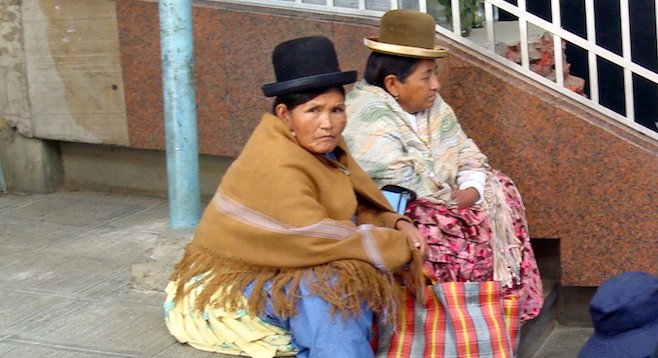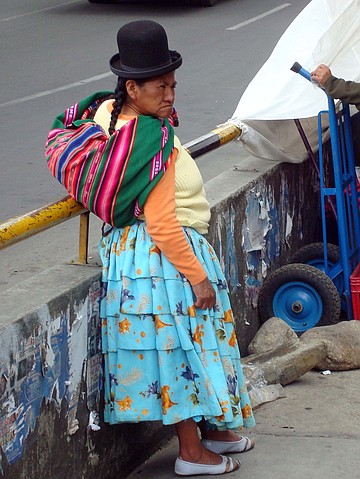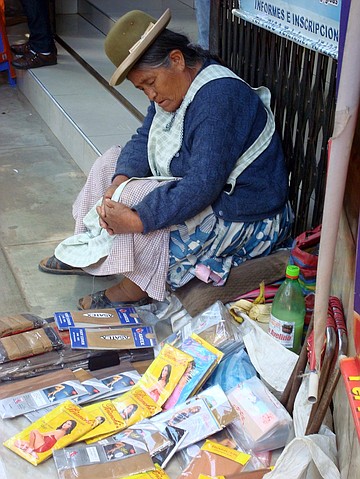 Facebook
Facebook
 X
X
 Instagram
Instagram
 TikTok
TikTok
 Youtube
Youtube

Bolivia is unique. It is the only country in the “New World” where the indigenous still predominate. Imagine if 65% of our population was still Native American (versus the less than one percent we have in our census), and you can begin to experience how different life feels today in Bolivia.
We began our trip in Cochabamba. Nestled in a broad valley, it has a year-round temperate climate, making it pleasant for people-watching while surrounded by flowerbeds, fresh air and great restaurants. Cochabamba makes it onto very few travelers’ itineraries, but it should – if for no other reason than to acclimate to the country’s high-altitude challenges.
It also reveals the good kind of sticker shock you'll experience throughout Bolivia. We picked up the tab for a dinner for five of silpancho, a large, thin milanesa steak covering a mound of rice, a layer of potatoes, then topped with a salad of tomatoes and onions and a crown of fried eggs. That, along with a couple of bottles of tumbo juice, a delicious passionfruit concoction, cost a grand total of $18.
Next, we moved south and 1,000 feet higher to Sucre, a delightful colonial city gently crumbling with age that seems perennially bewildered at finding itself in the 20th century. Although it's legally the capital of Bolivia, with the Supreme Court located there, it has none of the other trappings of government and seems to relish its small-town atmosphere. Since all its buildings are required to be whitewashed annually, there is a wonderful consistency in its streetscapes, which are accented by glimpses of the flowered patios sheltered inside. Sucre is the real showpiece of Bolivia, and was declared a UNESCO World Heritage site in 1991.
By now, we were ready to tackle the higher elevations and thinner air that give Bolivia a negative reputation with some travelers.
At an elevation of about 13,000 feet, Potosí is a powerful symbol of the natural wealth of the country and the ever-present struggle between the ruling classes and the dispossessed. The amount of silver that has been extracted from nearby Cerro Rico defies the imagination. We chose not to take a tour of the mines where you can witness the appalling working conditions that still persist, and instead concentrated on the process of how coins were minted, as well as viewing a few of the 80 over-the-top ornate churches where Spaniards offered their thanks to God for all that silver and tin they extracted.
Potosí is also the place to view the lavish decoration and objets d’art that Bolivia’s new aristocracy ordered from Europe with their new-found wealth.
Finally, we journeyed to La Paz, located in the depths of a huge gulley – not the usual place to park a major city, but at least protected from the winds of the Altiplano. About the best that can be said for its topology is that it's almost impossible to get lost: look downward and you're headed towards the central avenue. Rolling under the avenue is the hugely polluted Rio Choqueyapu, which, thankfully, for the protection of citizens’ olfactory systems, is encased in the downtown area.
Travel between regions is difficult, even though the distances are not far. The usual mode of travel is by bus, and it seems the preferred schedule is overnight, undoubtedly to avoid watching the driver take those harrowing hairpin turns. Adding to the dangerous geography is the tendency for bus drivers to pass the time by drinking.
After public agitation, it was decreed that a policeman must come aboard and administer a breathalyzer test at the start of each journey. He then proceeds to strut its results up and down the aisles for all to witness. The gentleman next to me, when presented with the results, commented to his wife, “Well, not yet drunk, at least!”

An aspect of culture that contributes greatly to the feeling of being in another time and place is the wearing of traditional clothing, so much so that it has been called a totem of citizens’ pride in their heritage. Bolivian indigenous women generally braid their long hair, and wear heavy, long, multi-layer pleated colorful skirts called polleras. Purportedly, these skirts were imposed by the Spanish, as a kind of romantic notion of the equivalent Spanish peasant lady of the day. On her back is an aguayo, a multi-colored, hand-loomed lamb’s wool or alpaca fabric that serves as a kind of sling to carry produce and/or their children.
I swear that I've seen fifty pounds of potatoes spew forth from the aguayo, and once I noted three babies peering out from beneath the blanket.
With the baby still in the aguayo, mothers toss their child to the front in a single motion to begin nursing. Somehow, this looked remarkably like the follow-through on a backhand tennis stroke, but these ladies didn’t look like they spent a lot of time at the country club.
Probably the most interesting part of a woman’s costume, and one that changes from region to region, is her hat. In Cochabamba, hats are crocheted, and strong stiffening applied. Frequently, they are adorned with ribbon or beads, giving them the look of a hat at a Sunday school picnic in the South. Sucre hats, on the other hand, worn by both men and women, were more like what we think of as a cowboy hat, usually felt and with a wide rim.

In La Paz, the brown bowler or derby is king. The urban myth is that some Brit imported them for Europeans living in Bolivia, but found their size to be too small, so came up with a marketing strategy to make Bolivians women feel these hats were the height of fashion. Just as was the case with the polleras, Bolivian women have maintained these styles long since they have disappeared in Spain and England.
Lonely Planet has declared Bolivia one of the top 10 best value countries to visit in 2013. Go there for a change of pace!


Bolivia is unique. It is the only country in the “New World” where the indigenous still predominate. Imagine if 65% of our population was still Native American (versus the less than one percent we have in our census), and you can begin to experience how different life feels today in Bolivia.
We began our trip in Cochabamba. Nestled in a broad valley, it has a year-round temperate climate, making it pleasant for people-watching while surrounded by flowerbeds, fresh air and great restaurants. Cochabamba makes it onto very few travelers’ itineraries, but it should – if for no other reason than to acclimate to the country’s high-altitude challenges.
It also reveals the good kind of sticker shock you'll experience throughout Bolivia. We picked up the tab for a dinner for five of silpancho, a large, thin milanesa steak covering a mound of rice, a layer of potatoes, then topped with a salad of tomatoes and onions and a crown of fried eggs. That, along with a couple of bottles of tumbo juice, a delicious passionfruit concoction, cost a grand total of $18.
Next, we moved south and 1,000 feet higher to Sucre, a delightful colonial city gently crumbling with age that seems perennially bewildered at finding itself in the 20th century. Although it's legally the capital of Bolivia, with the Supreme Court located there, it has none of the other trappings of government and seems to relish its small-town atmosphere. Since all its buildings are required to be whitewashed annually, there is a wonderful consistency in its streetscapes, which are accented by glimpses of the flowered patios sheltered inside. Sucre is the real showpiece of Bolivia, and was declared a UNESCO World Heritage site in 1991.
By now, we were ready to tackle the higher elevations and thinner air that give Bolivia a negative reputation with some travelers.
At an elevation of about 13,000 feet, Potosí is a powerful symbol of the natural wealth of the country and the ever-present struggle between the ruling classes and the dispossessed. The amount of silver that has been extracted from nearby Cerro Rico defies the imagination. We chose not to take a tour of the mines where you can witness the appalling working conditions that still persist, and instead concentrated on the process of how coins were minted, as well as viewing a few of the 80 over-the-top ornate churches where Spaniards offered their thanks to God for all that silver and tin they extracted.
Potosí is also the place to view the lavish decoration and objets d’art that Bolivia’s new aristocracy ordered from Europe with their new-found wealth.
Finally, we journeyed to La Paz, located in the depths of a huge gulley – not the usual place to park a major city, but at least protected from the winds of the Altiplano. About the best that can be said for its topology is that it's almost impossible to get lost: look downward and you're headed towards the central avenue. Rolling under the avenue is the hugely polluted Rio Choqueyapu, which, thankfully, for the protection of citizens’ olfactory systems, is encased in the downtown area.
Travel between regions is difficult, even though the distances are not far. The usual mode of travel is by bus, and it seems the preferred schedule is overnight, undoubtedly to avoid watching the driver take those harrowing hairpin turns. Adding to the dangerous geography is the tendency for bus drivers to pass the time by drinking.
After public agitation, it was decreed that a policeman must come aboard and administer a breathalyzer test at the start of each journey. He then proceeds to strut its results up and down the aisles for all to witness. The gentleman next to me, when presented with the results, commented to his wife, “Well, not yet drunk, at least!”

An aspect of culture that contributes greatly to the feeling of being in another time and place is the wearing of traditional clothing, so much so that it has been called a totem of citizens’ pride in their heritage. Bolivian indigenous women generally braid their long hair, and wear heavy, long, multi-layer pleated colorful skirts called polleras. Purportedly, these skirts were imposed by the Spanish, as a kind of romantic notion of the equivalent Spanish peasant lady of the day. On her back is an aguayo, a multi-colored, hand-loomed lamb’s wool or alpaca fabric that serves as a kind of sling to carry produce and/or their children.
I swear that I've seen fifty pounds of potatoes spew forth from the aguayo, and once I noted three babies peering out from beneath the blanket.
With the baby still in the aguayo, mothers toss their child to the front in a single motion to begin nursing. Somehow, this looked remarkably like the follow-through on a backhand tennis stroke, but these ladies didn’t look like they spent a lot of time at the country club.
Probably the most interesting part of a woman’s costume, and one that changes from region to region, is her hat. In Cochabamba, hats are crocheted, and strong stiffening applied. Frequently, they are adorned with ribbon or beads, giving them the look of a hat at a Sunday school picnic in the South. Sucre hats, on the other hand, worn by both men and women, were more like what we think of as a cowboy hat, usually felt and with a wide rim.

In La Paz, the brown bowler or derby is king. The urban myth is that some Brit imported them for Europeans living in Bolivia, but found their size to be too small, so came up with a marketing strategy to make Bolivians women feel these hats were the height of fashion. Just as was the case with the polleras, Bolivian women have maintained these styles long since they have disappeared in Spain and England.
Lonely Planet has declared Bolivia one of the top 10 best value countries to visit in 2013. Go there for a change of pace!
Comments